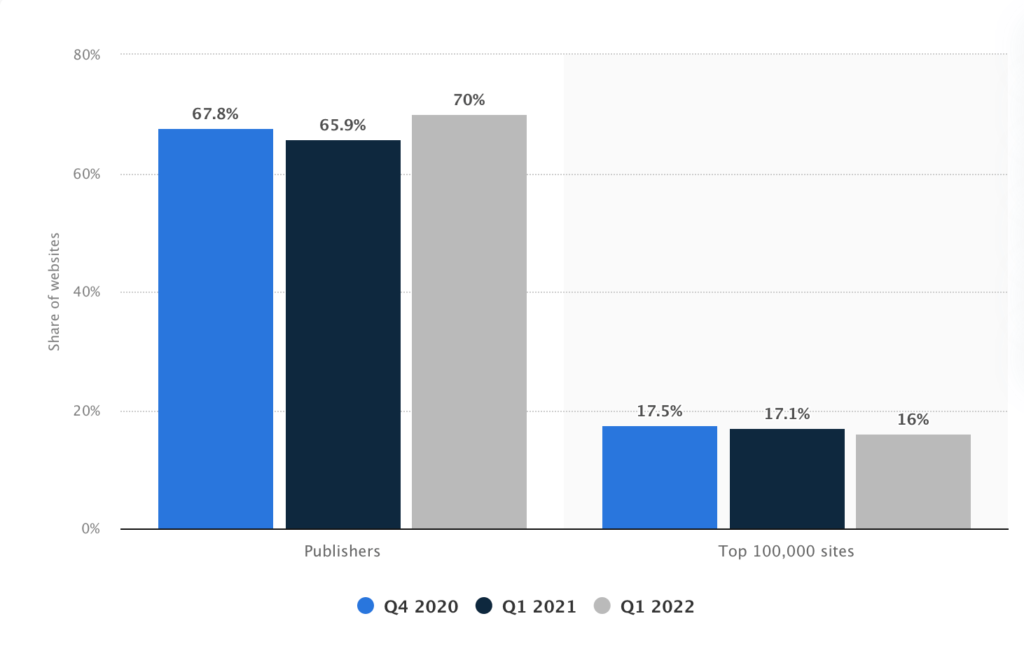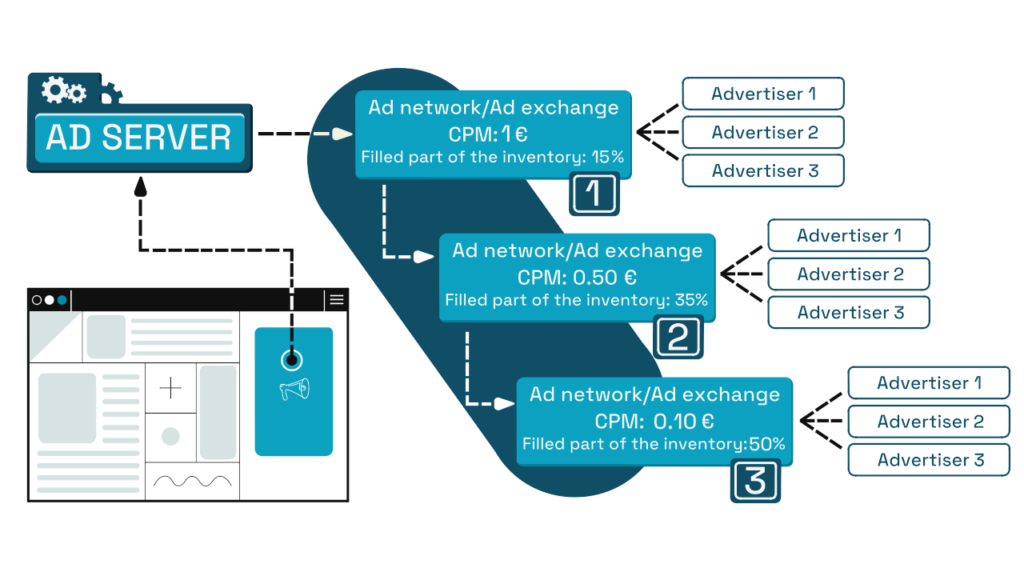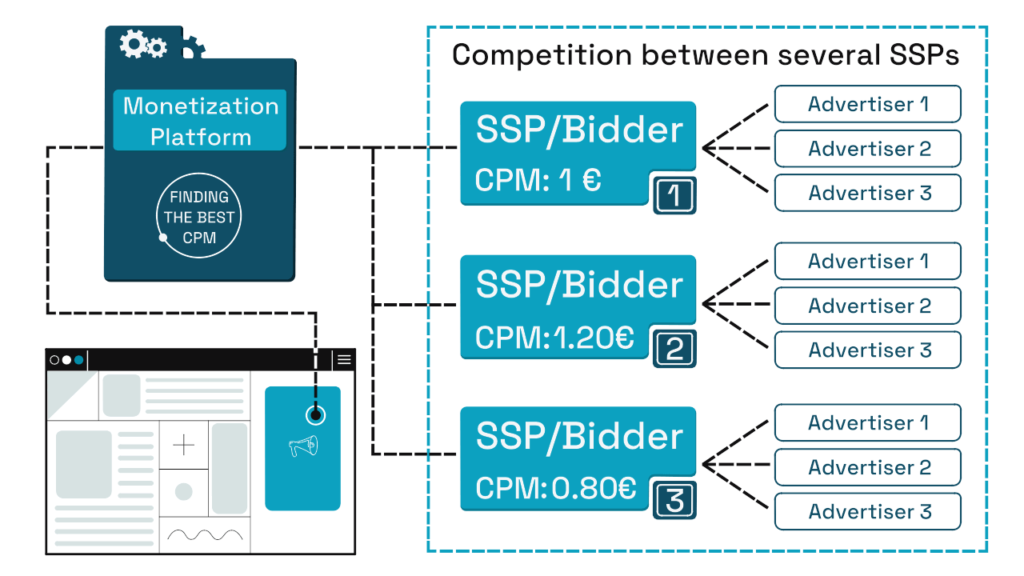What is Header Bidding? | A Complete Guide for Publishers
Header bidding is an advanced programmatic advertising technique used in digital advertising. Many publishers seek to leverage header bidding themselves thanks to its ability to offer ad inventory to multiple demand partners simultaneously and increase yield.
Header bidding collects bids on the publisher’s webpage before making the request to the ad server (like Google Ad Manager). Therefore, publishers aren’t bound to sell their ad inventory to Google unless it’s the highest bidder. The whole process is transparent and fair to the publisher.
This article explains what header bidding is and goes in-depth about the ins and outs of this technology.
The adoption rate for header bidding technology has reached 70% in the United States in the first quarter of 2022.

Source: Statista
What is Header Bidding?
Header bidding, also known as pre-bidding or prebid, is a programmatic technology whereby publishers simultaneously offer their ad inventory to many demand partners like Google.
Letting multiple demand partners (SSPs, ad exchanges) bid on the same ad inventory creates more competition, enabling publishers to sell their ad inventory for the highest possible price.
History of Header Bidding
Header bidding became an industry standard around 2014 when it replaced another popular technique of selling ad inventory–waterfall.
Waterfall, also known as daisy chaining, was initially developed as a technique for publishers to sell remnant ad inventory. In the past, publishers primarily relied on direct deals, which also had the highest priority in their ad server.
Once the publisher sold all his direct campaigns, the rest of the ad inventory would be passed to demand partners who would bid on it in a waterfall (sequence) model.
The demand partners (SSPs/ad networks) are ranked based on their size and the average historic performance they have produced for the publisher. This means that SSPs/ad networks with the best record of eCPM, fill rate, latency, etc., will be at the top.
The impressions are then passed from one SSP/ad network to another until they’re sold. During this process, the CPM prices decrease, and there’s access to more premium ad inventory that advertisers could bid on.

Because of inefficiencies related to the waterfall, the industry demanded a better solution. That’s how header bidding made it to the scene. After about a year, more big players started talking about it, and this technology was widely adopted.
In 2015, the AdExchanger published an article titled “The Rise Of ‘Header Bidding’ And The End Of The Publisher Waterfall,” officially marking the new era of programmatic advertising.
Header bidding effectively addressed two main issues both the sell-side and the buy-side were fighting:
- It allowed publishers to maximize the revenue from every sold ad impression.
- It allowed advertisers to have an equal chance to participate in the auction and bid on the ad inventory they wanted.
How Does Header Bidding Work?
Here is how header bidding works:
- Firstly, publishers need to paste the header bidding code in the header of the page.
- As soon as the user visits the site, the wrapper makes an ad call to all demand partners.
- The demand partners now submit their bids. There is usually a time frame or a timeout in which bidders must respond to prevent page latency (usually, this time is around 200—600ms).
- Then, the wrapper sends the bids to the publisher’s ad server, for example, Google Ad Manager.
- The highest bidder wins the real-time auction, and his ad creative gets displayed on the publisher’s page.

A header bidding technology is, in most cases, facilitated by prebid.js, which is an open-source header bidding wrapper responsible for the following:
- making ad calls to demand partners;
- evaluating bids;
- communicating with the ad server.
Let’s look at both of these in turn.
What is Prebid.js?
Prebid.js, also known as a prebid wrapper or header bidding wrapper, is an open-source solution that simplifies header bidding implementation on publishers’ websites and mobile apps.
It was designed in 2015 by AppNexus and is by far the most popular and widely adopted header bidding wrapper on the web.
Prebid.js is an open-source technology which means it’s free and allows everyone to contribute to its development. It also provides the most extensive collection of functional header bidding adapters.
However, implementing and consistently maintaining prebid.js is difficult for a publisher without a dedicated AdOps team.
Setupad’s Header Bidding Wrapper is built using prebid.js and is optimized for smooth integration into a website’s source code or the publisher’s ad server (like GAM). It comes as a fully managed service and support–from ad tag creation and implementation to predefined blocklists to avoid unwanted and low-quality ads.
Despite its market dominance, prebid.js is not the only header bidding wrapper. The next most popular solutions are Amazon’s Transparent Ad Marketplace (TAM), Amazon’s Unified Ad Marketplace (UAM), and Google’s Open Bidding (OB), which will be discussed later in this article.
For publishers looking for a more robust and sophisticated technology that would connect a publisher’s ad space and optimize direct campaigns with programmatic demand partners, Setupad has developed Setupad Prebid. This technology is a customized prebid.js software designed for advanced in-house website monetization.
What is Header Bidding Wrapper?
Header bidding wrapper is a Javascript tag-based monetization solution. It’s a code template that connects publishers’ ad space with demand partners (SSPs and ad exchanges).
After the tag is launched on the publisher’s website, all demand partners can simultaneously bid and compete in the same header bidding auction, increasing publishers’ ad revenue. A timeout will usually be set to prevent the partners from responding too long and minimize the impact on the website loading speed.
Publishers also have a high degree of control with the header bidding wrapper and can easily add and remove the buyers from the header bidding process, depending on their performance.
Header bidding wrapper is usually implemented through the publisher’s ad server or directly into a website’s source code.
Setupad’s prebid.js header bidding wrapper is hybrid because it combines the most valuable bids on the client side with bidding on the server side. Thus, it runs both on the browser side and the server side. That way, publishers get the most revenue without compromising speed.
What is Client-Side Header Bidding?
Client-side header bidding, also known as browser-side header bidding, is a type of header bidding where the auction happens on the user’s web browser, such as Google Chrome. It’s currently the most popular type of header bidding utilized by most publishers and monetization platforms.
When the JavaScript tag fires in client-side header bidding, the user’s browser sends out many ad requests to demand partners. If the publisher has an ad server, an additional request will be sent to the ad server where the highest bid from the header bidding auction will compete with the publisher’s direct deals. After that, the header bidding wrapper will select the highest bidder whose ad will get displayed.
What is Server-Side Header Bidding?
The server-side header bidding concept is similar to the client-side header bidding, but instead of sending many ad requests and holding header bidding auctions in the user’s web browser, the user sends a single request to the server, which sends out many requests to SSP/ad exchanges. All bidders respond almost immediately without the involvement of the user’s browser.
Even though this approach is not that common, some publishers might entirely skip the client-side header bidding and use the server-side header bidding technology instead. Why? Because for many publishers, website speed advantage is of the highest importance.

What Are the Benefits of Header Bidding for Publishers?
1. Multiple demand partners competing for the same ad inventory.
2. Control over demand partners, price floors, timeouts, and more.
3. Revenue uplift by 30-80% over Google AdSense.
4. Advanced reporting and analytics using bid-level data.
5. Reduced risk of underselling ad inventory.
6. Minimum ad discrepancy thanks to a single auction.
7. Increased fill rate.
What Are the Benefits of Header Bidding for Advertisers?
1. Opportunity to bid on the premium inventory without having to be involved in a direct deal with a publisher.
2. Publishers get to share bid-level data with advertisers so they can adjust their bidding decisions for the future.
What Are The Disadvantages of Header Bidding?
1. Complicated implementation and maintenance unless working with a monetization platform (like Setupad).
2. High page latency with client-side header bidding.
Header bidding vs RTB
Header bidding is just one of the ways the ad inventory can be sold through RTB.
Real-time bidding is a method of buying and selling digital ads through real-time auctions. It’s traditionally associated with the open auction. However, it can also include:
- header bidding;
- waterfall;
- private auction;
- preferred deals;
- programmatic guaranteed;
- and more.
Header Bidding vs Google AdSense
Google AdSense is one of the most popular advertising platforms for website monetization. The main difference between Google AdSense and header bidding is that in Google AdSense, there is only one demand partner (Google), which means publishers cannot sell ad impressions for the highest price as they do with header bidding.
AdSense pays publishers based on the cost-per-click (CPC) model. With header bidding, publishers get paid based on the cost-per-impression (CPM) model.
Therefore, publishers can significantly uplift their ad revenue with header bidding. For example, New Club Penguin saw a 300% eCPM increase after switching from Google AdSense to Setupad.
Setupad Prebid AdSense – Combine Your AdSense and Prebid Earnings
In addition, AdSense can be integrated into your header bidding setup because Google AdX (one of the biggest players usually available through header bidding platforms like Setupad) includes AdSense demand by default.
Setupad Prebid AdSense is a product we designed specifically for large AdSense publishers who want to combine AdSense demand with Setupad’s Prebid demand from 30+ premium SSPs, increase bid density, and drastically increase their earnings.
This type of integration is especially effective for publishers with historically high CTRs and, as a result, good AdSense results.
What Do My Monetization Results Depend On?
Your monetization results may depend on several factors:
- The content and desired outcomes of your website. For example, are you providing services, educational content, designing tools, or news? You have to understand your target audience before you can gain maximum results.
- Quality and quantity of demand partners competing for your ad inventory. Your demand partners ideally have to be relevant to your website’s niche to deliver the best performance.
- The traffic of your website. Specifically, the amount and geolocation (Tier 1, 2, 3) of your traffic.
- The ad viewability and average CTR results of your website.
FAQ
1. What is Amazon’s Transparent Ad Marketplace (TAM)?
Amazon Transparent Ad Marketplace, also known as Amazon TAM, is a server-side header bidding wrapper aimed for large (enterprise) publishers with their own connection to major ad exchanges, like Magnite and PubMatic. It is available by invitation only.
Publishers using TAM benefit from access to Amazon’s demand on top of their existing SSP partners. However, TAM is not a managed service, so publishers need to handle the technical implementation of header bidding by themselves.
2. What is Amazon’s Unified Ad Marketplace (UAM)?
Amazon’s Unified Ad Marketplace, also known as Amazon UAM, is also a server-to-server header bidding wrapper aimed at small and medium publishers who usually don’t have direct SSP relationships. With UAM, Amazon makes its own SSPs available for publishers like Pubmatic, Rubicon Project, and others.
One of the main benefits of UAM is that it can be integrated with your current header bidding setup. However, UAM is an invite-only platform and is limited to a few geos like the U.S., making accessing it hard.
3. What is Open Bidding?
In response to the worldwide adoption of header bidding, Google has developed its own version of header bidding known as Open Bidding (formerly known as Exchange Bidding in Dynamic Allocation or EBDA).
It’s handled by Google Ad Manager using server-to-server integration, which means the auction between third-party demand partners takes place on the server instead of the user’s browser. This integration allows for faster bid response, which results in faster page load speed, better user experience, and ad viewability.
Open Bidding also provides simplified trafficking and reporting through an interface called yield groups.
4. What is a header bidding platform?
Header bidding platforms are known as monetization platforms, like Setupad. These platforms offer publishers fully managed website monetization solutions and customer support.
As mentioned, prebid.js is an open-source header bidding wrapper, but maintaining it is a tedious task that requires technical resources.
In addition, you still need the following:
- adding multiple SSPs to maximize competition for your ad inventory, which might not be possible for small-medium publishers;
- a dedicated AdOps team to take care of HB implementation and ad optimization;
- granular optimization within Google Ad Manager or for prebid.js to achieve maximum efficiency in terms of ad revenue;
- malvertising control.
Setupad offers its clients all of the above. Moreover, we connect publishers to 20+ SSPs, including Google, which is an optimal SSP number.
Conclusion
Header bidding has quickly taken over the adtech world. However, the industry evolves every day, so it is important to work with a platform with which header bidding solution is competitive and up-to-date.
Setupad’s header bidding solution consists of the most advanced and complete ad stack. Our hybrid header bidding wrapper includes server-to-server integrations to Prebid server, Amazon’s TAM, and Google’s Open Bidding, which together account for at least 35% of the winning bids. Our clients benefit from superior customer service and an individual approach.
Still don’t know if header bidding is right for your website? Reach out at [email protected] or sign up to test the solution!


